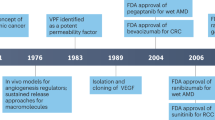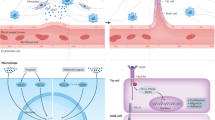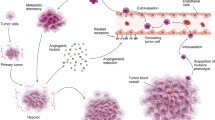Abstract
Blood vessels deliver oxygen and nutrients to every part of the body, but also nourish diseases such as cancer. Over the past decade, our understanding of the molecular mechanisms of angiogenesis (blood vessel growth) has increased at an explosive rate and has led to the approval of anti-angiogenic drugs for cancer and eye diseases. So far, hundreds of thousands of patients have benefited from blockers of the angiogenic protein vascular endothelial growth factor, but limited efficacy and resistance remain outstanding problems. Recent preclinical and clinical studies have shown new molecular targets and principles, which may provide avenues for improving the therapeutic benefit from anti-angiogenic strategies.
This is a preview of subscription content, access via your institution
Access options
Subscribe to this journal
Receive 51 print issues and online access
$199.00 per year
only $3.90 per issue
Buy this article
- Purchase on SpringerLink
- Instant access to full article PDF
Prices may be subject to local taxes which are calculated during checkout



Similar content being viewed by others
References
Folkman, J. Angiogenesis: an organizing principle for drug discovery? Nature Rev. Drug Discov. 6, 273–286 (2007).
Carmeliet, P. Angiogenesis in health and disease. Nature Med. 9, 653–660 (2003).
Swift, M. R. & Weinstein, B. M. Arterial–venous specification during development. Circ. Res. 104, 576–588 (2009).
Wang, R. et al. Glioblastoma stem-like cells give rise to tumour endothelium. Nature 468, 829–833 (2010).
Schaper, W. Collateral circulation: past and present. Basic Res. Cardiol. 104, 5–21 (2009).
Jain, R. K., Duda, D. G., Clark, J. W. & Loeffler, J. S. Lessons from phase III clinical trials on anti-VEGF therapy for cancer. Nature Clin. Pract. Oncol. 3, 24–40 (2006).
Ferrara, N. VEGF-A: a critical regulator of blood vessel growth. Eur. Cytokine Netw. 20, 158–163 (2009).
Nagy, J. A., Dvorak, A. M. & Dvorak, H. F. VEGF-A and the induction of pathological angiogenesis. Annu. Rev. Pathol. 2, 251–275 (2007).
Neufeld, G. & Kessler, O. The semaphorins: versatile regulators of tumour progression and tumour angiogenesis. Nature Rev. Cancer 8, 632–645 (2008).
Phng, L. K. & Gerhardt, H. Angiogenesis: a team effort coordinated by Notch. Dev. Cell 16, 196–208 (2009).
Stockmann, C. et al. Deletion of vascular endothelial growth factor in myeloid cells accelerates tumorigenesis. Nature 456, 814–818 (2008).
Lee, S. et al. Autocrine VEGF signaling is required for vascular homeostasis. Cell 130, 691–703 (2007).
Lanahan, A. A. et al. VEGF receptor 2 endocytic trafficking regulates arterial morphogenesis. Dev. Cell 18, 713–724 (2010).
Jain, R. K. et al. Biomarkers of response and resistance to antiangiogenic therapy. Nature Rev. Clin. Oncol. 6, 327–338 (2009). This review highlights the importance of various types of biomarker to personalize anti-angiogenic medicine, distinguish responders from non-responders and monitor treatment efficacy and adverse effects.
Buysschaert, I., Schmidt, T., Roncal, C., Carmeliet, P. & Lambrechts, D. Genetics, epigenetics and pharmaco-(epi)genomics in angiogenesis. J. Cell. Mol. Med. 12, 2533–2551 (2008).
Tvorogov, D. et al. Effective suppression of vascular network formation by combination of antibodies blocking VEGFR ligand binding and receptor dimerization. Cancer Cell 18, 630–640 (2010).
Tammela, T. & Alitalo, K. Lymphangiogenesis: molecular mechanisms and future promise. Cell 140, 460–476 (2010).
Herbert, S. P. et al. Arterial–venous segregation by selective cell sprouting: an alternative mode of blood vessel formation. Science 326, 294–298 (2009).
Fischer, C., Mazzone, M., Jonckx, B. & Carmeliet, P. FLT1 and its ligands VEGFB and PlGF: drug targets for anti-angiogenic therapy? Nature Rev. Cancer 8, 942–956 (2008).
Carmeliet, P. et al. Synergism between vascular endothelial growth factor and placental growth factor contributes to angiogenesis and plasma extravasation in pathological conditions. Nature Med. 7, 575–583 (2001).
Rolny, C. et al. HRG inhibits tumor growth and metastasis by inducing macrophage polarization and vessel normalization through downregulation of PlGF. Cancer Cell 19, 31–44 (2011).
Van de Veire, S. et al. Further pharmacological and genetic evidence for the efficacy of PlGF inhibition in cancer and eye disease. Cell 141, 178–190 (2010).
Bais, C. et al. PlGF blockade does not inhibit angiogenesis during primary tumor growth. Cell 141, 166–177 (2010).
Hagberg, C. E. et al. Vascular endothelial growth factor B controls endothelial fatty acid uptake. Nature 464, 917–921 (2010).
Bry, M. et al. Vascular endothelial growth factor-B acts as a coronary growth factor in transgenic rats without inducing angiogenesis, vascular leak, or inflammation. Circulation 122, 1725–1733 (2010).
Schwartz, J. D., Rowinsky, E. K., Youssoufian, H., Pytowski, B. & Wu, Y. Vascular endothelial growth factor receptor-1 in human cancer. Cancer 116, 1027–1032 (2010).
Lichtenberger, B. M. et al. Autocrine VEGF signaling synergizes with EGFR in tumor cells to promote epithelial cancer development. Cell 140, 268–279 (2010).
Duda, D. G. & Jain, R. K. Premetastatic lung 'niche': is vascular endothelial growth factor receptor 1 activation required? Cancer Res. 70, 5670–5673 (2010).
Kaplan, R. N. et al. VEGFR1-positive haematopoietic bone marrow progenitors initiate the pre-metastatic niche. Nature 438, 820–827 (2005).
Jain, R. K. Molecular regulation of vessel maturation. Nature Med. 9, 685–693 (2003).
Hellberg, C., Ostman, A. & Heldin, C. H. PDGF and vessel maturation. Recent Results Cancer Res. 180, 103–114 (2010).
Gaengel, K., Genove, G., Armulik, A. & Betsholtz, C. Endothelial-mural cell signaling in vascular development and angiogenesis. Arterioscler. Thromb. Vasc. Biol. 29, 630–638 (2009). This article discusses the role of pericytes in tumour angiogenesis, and highlights the possible pro-metastatic effects of blocking pericyte coverage.
Quaegebeur, A., Segura, I. & Carmeliet, P. Pericytes: blood–brain barrier safeguards against neurodegeneration? Neuron 68, 321–323 (2010).
Song, S., Ewald, A. J., Stallcup, W., Werb, Z. & Bergers, G. PDGFRβ+ perivascular progenitor cells in tumours regulate pericyte differentiation and vascular survival. Nature Cell Biol. 7, 870–879 (2005).
Bergers, G., Song, S., Meyer-Morse, N., Bergsland, E. & Hanahan, D. Benefits of targeting both pericytes and endothelial cells in the tumor vasculature with kinase inhibitors. J. Clin. Invest. 111, 1287–1295 (2003).
McCarty, M. F. et al. Overexpression of PDGF-BB decreases colorectal and pancreatic cancer growth by increasing tumor pericyte content. J. Clin. Invest. 117, 2114–2122 (2007).
Sennino, B. et al. Cellular source and amount of vascular endothelial growth factor and platelet-derived growth factor in tumors determine response to angiogenesis inhibitors. Cancer Res. 69, 4527–4536 (2009).
Nisancioglu, M. H., Betsholtz, C. & Genove, G. The absence of pericytes does not increase the sensitivity of tumor vasculature to vascular endothelial growth factor-A blockade. Cancer Res. 70, 5109–5115 (2010).
Gerhardt, H. & Semb, H. Pericytes: gatekeepers in tumour cell metastasis? J. Mol. Med. 86, 135–144 (2008).
Lebrin, F. et al. Thalidomide stimulates vessel maturation and reduces epistaxis in individuals with hereditary hemorrhagic telangiectasia. Nature Med. 16, 420–428 (2010).
Crawford, Y. et al. PDGF-C mediates the angiogenic and tumorigenic properties of fibroblasts associated with tumors refractory to anti-VEGF treatment. Cancer Cell 15, 21–34 (2009).
di Tomaso, E. et al. PDGF-C induces maturation of blood vessels in a model of glioblastoma and attenuates the response to anti-VEGF treatment. PLoS ONE 4, e5123 (2009).
Pardali, E., Goumans, M. J. & ten Dijke, P. Signaling by members of the TGF-β family in vascular morphogenesis and disease. Trends Cell Biol. 20, 556–567 (2010).
Beenken, A. & Mohammadi, M. The FGF family: biology, pathophysiology and therapy. Nature Rev. Drug Discov. 8, 235–253 (2009).
Murakami, M. et al. The FGF system has a key role in regulating vascular integrity. J. Clin. Invest. 118, 3355–3366 (2008).
Bergers, G. & Hanahan, D. Modes of resistance to anti-angiogenic therapy. Nature Rev. Cancer 8, 592–603 (2008).
Augustin, H. G., Koh, G. Y., Thurston, G. & Alitalo, K. Control of vascular morphogenesis and homeostasis through the angiopoietin–Tie system. Nature Rev. Mol. Cell Biol. 10, 165–177 (2009).
Saharinen, P. et al. Angiopoietins assemble distinct Tie2 signalling complexes in endothelial cell–cell and cell–matrix contacts. Nature Cell Biol. 10, 527–537 (2008).
De Palma, M. et al. Tie2 identifies a hematopoietic lineage of proangiogenic monocytes required for tumor vessel formation and a mesenchymal population of pericyte progenitors. Cancer Cell 8, 211–226 (2005).
Falcon, B. L. et al. Contrasting actions of selective inhibitors of angiopoietin-1 and angiopoietin-2 on the normalization of tumor blood vessels. Am. J. Pathol. 175, 2159–2170 (2009).
Koh, Y. J. et al. Double antiangiogenic protein, DAAP, targeting VEGF-A and angiopoietins in tumor angiogenesis, metastasis, and vascular leakage. Cancer Cell 18, 171–184 (2010).
Benedito, R. et al. The Notch ligands Dll4 and Jagged1 have opposing effects on angiogenesis. Cell 137, 1124–1135 (2009).
Phng, L. K. et al. Nrarp coordinates endothelial Notch and Wnt signaling to control vessel density in angiogenesis. Dev. Cell 16, 70–82 (2009).
Jakobsson, L. et al. Endothelial cells dynamically compete for the tip cell position during angiogenic sprouting. Nature Cell Biol. 12, 943–953 (2010).
Thurston, G., Noguera-Troise, I. & Yancopoulos, G. D. The Delta paradox: DLL4 blockade leads to more tumour vessels but less tumour growth. Nature Rev. Cancer 7, 327–331 (2007). References 10 and 55 discuss the molecular model of vessel branching, and the role of DLL4 and NOTCH signalling in tip- and stalk-cell formation.
Yan, M. et al. Chronic DLL4 blockade induces vascular neoplasms. Nature 463, E6–E7 (2010).
Corada, M. et al. The Wnt/β-catenin pathway modulates vascular remodeling and specification by upregulating Dll4/Notch signaling. Dev. Cell 18, 938–949 (2010).
Dejana, E. The role of Wnt signaling in physiological and pathological angiogenesis. Circ. Res. 107, 943–952 (2010).
Desgrosellier, J. S. & Cheresh, D. A. Integrins in cancer: biological implications and therapeutic opportunities. Nature Rev. Cancer 10, 9–22 (2010).
Hodivala-Dilke, K. αvβ3 integrin and angiogenesis: a moody integrin in a changing environment. Curr. Opin. Cell Biol. 20, 514–519 (2008).
Contois, L., Akalu, A. & Brooks, P. C. Integrins as 'functional hubs' in the regulation of pathological angiogenesis. Semin. Cancer Biol. 19, 318–328 (2009).
Deryugina, E. I. & Quigley, J. P. Pleiotropic roles of matrix metalloproteinases in tumor angiogenesis: contrasting, overlapping and compensatory functions. Biochim. Biophys. Acta 1803, 103–120 (2010).
Bergers, G. et al. Matrix metalloproteinase-9 triggers the angiogenic switch during carcinogenesis. Nature Cell Biol. 2, 737–744 (2000).
Iruela-Arispe, M. L. & Davis, G. E. Cellular and molecular mechanisms of vascular lumen formation. Dev. Cell 16, 222–231 (2009).
Du, R. et al. HIF1α induces the recruitment of bone marrow-derived vascular modulatory cells to regulate tumor angiogenesis and invasion. Cancer Cell 13, 206–220 (2008).
Heissig, B. et al. Role of neutrophil-derived matrix metalloproteinase-9 in tissue regeneration. Histol. Histopathol. 25, 765–770 (2010).
Heissig, B. et al. Recruitment of stem and progenitor cells from the bone marrow niche requires MMP-9 mediated release of kit-ligand. Cell 109, 625–637 (2002).
Blasi, F. & Carmeliet, P. uPAR: a versatile signalling orchestrator. Nature Rev. Mol. Cell Biol. 3, 932–943 (2002).
Pries, A. R., Hopfner, M., le Noble, F., Dewhirst, M. W. & Secomb, T. W. The shunt problem: control of functional shunting in normal and tumour vasculature. Nature Rev. Cancer 10, 587–593 (2010).
Dejana, E., Tournier-Lasserve, E. & Weinstein, B. M. The control of vascular integrity by endothelial cell junctions: molecular basis and pathological implications. Dev. Cell 16, 209–221 (2009).
Strilic, B. et al. The molecular basis of vascular lumen formation in the developing mouse aorta. Dev. Cell 17, 505–515 (2009).
Mazzone, M. et al. Heterozygous deficiency of PHD2 restores tumor oxygenation and inhibits metastasis via endothelial normalization. Cell 136, 839–851 (2009). This article provides genetic evidence of a role for the oxygen-sensor PHD2 in tumour vessel normalization through its regulation of endothelial cell phalanx formation.
Duda, D. G. et al. CXCL12 (SDF1α) — CXCR4/CXCR7 pathway inhibition: an emerging sensitizer for anti-cancer therapies? Clin. Cancer Res. 17, 2074–2080 (2011).
Visentin, B. et al. Validation of an anti-sphingosine-1-phosphate antibody as a potential therapeutic in reducing growth, invasion, and angiogenesis in multiple tumor lineages. Cancer Cell 9, 225–238 (2006).
Kuhnert, F. et al. Essential regulation of CNS angiogenesis by the orphan G protein-coupled receptor GPR124. Science 330, 985–989 (2010).
Escudier, B. et al. Phase III trial of bevacizumab plus interferon alfa-2a in patients with metastatic renal cell carcinoma (AVOREN): final analysis of overall survival. J. Clin. Oncol. 28, 2144–2150 (2010).
Allegra, C. J. et al. Phase III trial assessing bevacizumab in stages II and III carcinoma of the colon: results of NSABP protocol C-08. J. Clin. Oncol. 29, 11–16 (2011).
Ebos, J. M. et al. Accelerated metastasis after short-term treatment with a potent inhibitor of tumor angiogenesis. Cancer Cell 15, 232–239 (2009).
Paez-Ribes, M. et al. Antiangiogenic therapy elicits malignant progression of tumors to increased local invasion and distant metastasis. Cancer Cell 15, 220–231 (2009). References 78 and 79 provide preclinical evidence that VEGF or VEGFR blockade can enhance metastasis, whereas references 87 and 88 provide preclinical and clinical evidence that VEGF or VEGFR blockade has no effect on metastasis.
Carmeliet, P. Angiogenesis in life, disease and medicine. Nature 438, 932–936 (2005).
Hida, K. et al. Tumor-associated endothelial cells with cytogenetic abnormalities. Cancer Res. 64, 8249–8255 (2004).
Ferrara, N. Pathways mediating VEGF-independent tumor angiogenesis. Cytokine Growth Factor Rev. 21, 21–26 (2010). References 46 and 82 discuss the mechanisms of resistance to VEGF or VEGFR blockade.
Nagengast, W. B. et al. VEGF-PET imaging is a noninvasive biomarker showing differential changes in the tumor during sunitinib treatment. Cancer Res. 71, 143–153 (2011).
Joyce, J. A. & Pollard, J. W. Microenvironmental regulation of metastasis. Nature Rev. Cancer 9, 239–252 (2009).
Mancuso, M. R. et al. Rapid vascular regrowth in tumors after reversal of VEGF inhibition. J. Clin. Invest. 116, 2610–2621 (2006).
di Tomaso, E. et al. Glioblastoma recurrence after cediranib therapy in patients: lack of “rebound” revascularization as mode of escape. Cancer Res. 71, 19–28 (2011).
Padera, T. P. et al. Differential response of primary tumor versus lymphatic metastasis to VEGFR-2 and VEGFR-3 kinase inhibitors cediranib and vandetanib. Mol. Cancer Ther. 7, 2272–2279 (2008).
Miles, D. et al. Disease course patterns after discontinuation of bevacizumab: pooled analysis of randomized phase III trials. J. Clin. Oncol. 29, 83–88 (2010).
Jain, R. K. Normalization of tumor vasculature: an emerging concept in antiangiogenic therapy. Science 307, 58–62 (2005). This review presents evidence for vascular abnormalities in tumours, and the therapeutic potential to normalize these vessels for treatment of cancer and other diseases characterized by abnormal vessels.
Jain, R. K. Normalizing tumor vasculature with anti-angiogenic therapy: a new paradigm for combination therapy. Nature Med. 7, 987–989 (2001).
Plotkin, S. R. et al. Hearing improvement after bevacizumab in patients with neurofibromatosis type 2. N. Engl. J. Med. 361, 358–367 (2009).
Butler, J. M., Kobayashi, H. & Rafii, S. Instructive role of the vascular niche in promoting tumour growth and tissue repair by angiocrine factors. Nature Rev. Cancer 10, 138–146 (2010). This review discusses the emerging concept that endothelial cells produce instructive signals for organ development, repair and even cancer. It also highlights the importance of hypoxia-mediated signalling in angiogenesis.
Adams, R. H. & Eichmann, A. Axon guidance molecules in vascular patterning. Cold Spring Harb. Perspect. Biol. 2, a001875 (2010).
Mosch, B., Reissenweber, B., Neuber, C. & Pietzsch, J. Eph receptors and ephrin ligands: important players in angiogenesis and tumor angiogenesis. J. Oncol. 2010, 135285 (2010).
Sawamiphak, S. et al. Ephrin-B2 regulates VEGFR2 function in developmental and tumour angiogenesis. Nature 465, 487–491 (2010).
Majmundar, A. J., Wong, W. J. & Simon, M. C. Hypoxia-inducible factors and the response to hypoxic stress. Mol. Cell 40, 294–309 (2010).
Fraisl, P., Mazzone, M., Schmidt, T. & Carmeliet, P. Regulation of angiogenesis by oxygen and metabolism. Dev. Cell 16, 167–179 (2009).
Arany, Z. et al. HIF-independent regulation of VEGF and angiogenesis by the transcriptional coactivator PGC-1α. Nature 451, 1008–1112 (2008). References 24, 97 and 98 discuss the link between metabolism and angiogenesis, and show that metabolic regulators control angiogenesis.
Ohtani, K. & Dimmeler, S. Control of cardiovascular differentiation by microRNAs. Basic Res. Cardiol. 106, 5–11 (2010). This review discusses the emerging evidence for regulation of angiogenesis by epigenetic mechanisms.
Nicoli, S. et al. MicroRNA-mediated integration of haemodynamics and Vegf signalling during angiogenesis. Nature 464, 1196–1200 (2010).
Acknowledgements
We would like to acknowledge the late J. Folkman for inspiring us and others to work in the area of tumour angiogenesis. We would like to thank L. Claeson-Welch, H. Augustin, E. Dejana, S. Kozin, D. G. Duda, S. Goel, L. L. Munn, G. Sledge, R. Stupp and H. D. Suit for their comments, and L. Notebaert for help with the illustrations. We apologize to the authors whose work we could not cite because of the limit on the number of references. The work of P.C. is supported by a Federal Government Belgium grant (IUAP06/30), long-term structural Methusalem funding by the Flemish Government, a Concerted Research Activities Belgium grant (GOA2006/11), Leducq Transatlantic Network ARTEMIS and a grant from Flanders Research Foundation (FWO G.0673.08). The research of R.K.J. is supported by US National Institutes of Health grants P01-CA80124, R01-CA85140, R01-CA115767 and R01-CA126642, Federal Share/NCI Proton Beam Program Income, the National Foundation for Cancer Research and a Department of Defense Breast Cancer Research Innovator Award (W81XWH-10-1-0016).
Author information
Authors and Affiliations
Corresponding authors
Ethics declarations
Competing interests
R.K.J. reports receiving consulting fees from Astellas, AstraZeneca, Dyax, Enlight Biosciences, Genzyme, Millenium, MorphoSys, Noxxon and SynDevRx; lecture fees from Alnylam, Genzyme, Pfizer and MPM Capital; and grant support from Dyax, AstraZeneca, MedImmune and Roche; and owns equity in Enlight Biosciences and SynDevRx. P.C. reports receiving recent consulting fees from Roche, ThromboGenics and Astellas; lecture fees from Roche and Novartis; and grant support from ThromboGenics; and owns equity in ThromboGenics.
Additional information
Reprints and permissions information is available at http://www.nature.com/reprints.
Rights and permissions
About this article
Cite this article
Carmeliet, P., Jain, R. Molecular mechanisms and clinical applications of angiogenesis. Nature 473, 298–307 (2011). https://doi.org/10.1038/nature10144
Published:
Issue Date:
DOI: https://doi.org/10.1038/nature10144
This article is cited by
-
Effects of acetazolamide combined with remote ischemic preconditioning on risk of acute mountain sickness: a randomized clinical trial
BMC Medicine (2024)
-
Deciphering the role of neddylation in tumor microenvironment modulation: common outcome of multiple signaling pathways
Biomarker Research (2024)
-
Mitochondrial transfer mediates endothelial cell engraftment through mitophagy
Nature (2024)
-
A brain-specific angiogenic mechanism enabled by tip cell specialization
Nature (2024)
-
NRP1 interacts with endoglin and VEGFR2 to modulate VEGF signaling and endothelial cell sprouting
Communications Biology (2024)



